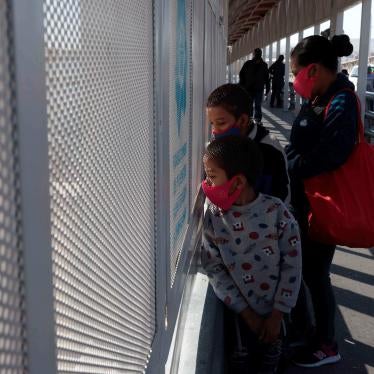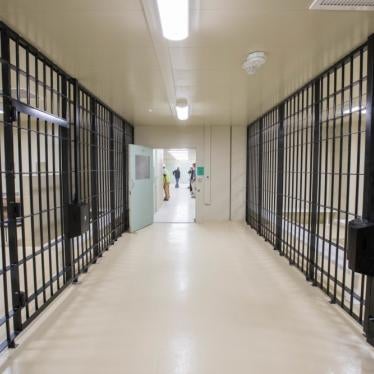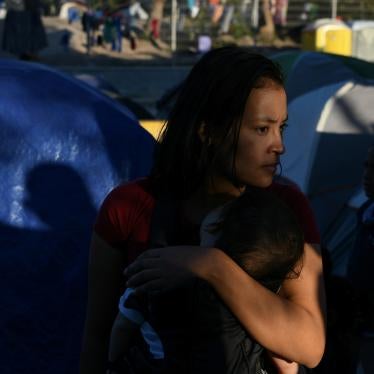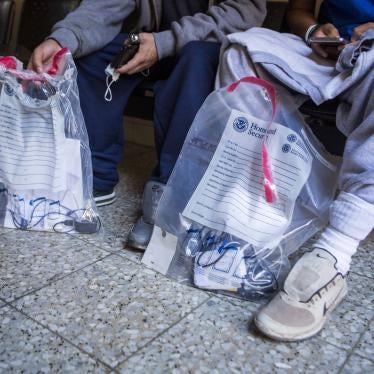Well before the Covid-19 pandemic, Stephen Miller, White House adviser to then-US President Donald Trump, floated the idea of using the government’s public health authority as a means of achieving the administration’s long-pursued goal of closing the border to asylum seekers. At the time, White House officials and attorneys reportedly told Miller, who has promoted white nationalist ideologies, and Trump that they lacked the legal authority to do so.
But as the US was hit hard by the Covid-19 pandemic, Trump administration officials pressured public health authorities to circumvent US and international law protecting refugees by ordering immigration authorities to summarily expel migrants without providing them the opportunity to seek protection in the United States.
This analysis covers the impact of the resulting March 2020 order from the US Centers for Disease Control and Prevention (CDC) under Title 42 of US law. Although President Joe Biden promised during his campaign to restore access to asylum at US borders, and has made an exception in processing unaccompanied children, close to 100 days into the Biden administration, Stephen Miller’s desired border closure remains largely in place. The Title 42 expulsion policy is illegal and violates the human rights of those subjected to it. The Biden administration, now complicit in those rights violations, should rescind the policy immediately while taking measures to ensure the humane and dignified reception of asylum seekers.
What is Title 42 and how does it work?
The Title 42 expulsion policy has effectively closed the US border to nearly all asylum seekers based on the misapplication of an obscure, 75-year-old public health law. That law, the Public Health Service Act of 1944, was designed to confer quarantine authority to health authorities that would apply to everyone, including US citizens, arriving from a foreign country. Quarantine authority was never meant to be used to determine which noncitizens could or couldn’t be expelled or removed from the US. In debating the law’s predecessor provision, Congress specifically kept any reference to immigrants or immigration out of the law’s text because of concerns that public health authority could be used to discriminate against immigrants. The 1944 version was enacted to shift quarantine authority from the president to the surgeon general.
Nevertheless, the order issued by the CDC, along with an accompanying rule published in the Federal Register, specifically bars just one category of people from entering the US: those crossing the borders from Mexico or Canada who would be held in congregate settings by US authorities, a category the order says will be primarily migrants who arrive without visas.
US law gives asylum seekers the right to seek asylum upon arrival in the United States, even if they arrive without inspection or prior authorization. Before expelling people who arrive in the US, US Customs and Border Protection (CBP) is legally required to conduct nonrefoulement screenings to ensure they do not expel people who need protection. Those screenings are designed to ensure that no one risks torture or other likely serious harm after being expelled and returned to their country of origin.
Since March 2020, Customs and Border Protection has carried out more than 642,700 expulsions under the order, typically without conducting the required screenings. Human Rights Watch research shows that the consequences of returning asylum seekers to danger can be catastrophic–resulting in sexual assault, torture, and death.
A leaked Border Patrol memo providing guidance on the order’s implementation instructs agents to process migrants for expulsion as quickly as possible, while providing a small exception for migrants who affirmatively present a claim for protection under the United Nations Convention against Torture and Other Cruel, Inhuman or Degrading Treatment or Punishment. Agents have unchecked authority to then determine whether to refer those migrants for an interview with an asylum officer.
Human Rights Watch has previously witnessed and documented CBP agents performing illegal “turnbacks” of migrants exercising their right to seek asylum. Human Rights Watch has also found agents have failed to refer for interviews with asylum officers people who have expressed a fear of return to their country of origin, and instead rapidly deported them to potential danger. Giving CBP agents even greater power to unilaterally and summarily decide claims under the expulsion order risks further wrongful return of people who may be refugees.
Migrants are either expelled to their country of origin or to Mexico, even if they are not from Mexico and even if they do not speak Spanish. In some cases, US border agents turn migrants directly over to Mexican immigration authorities, who then immediately detain and deport them. There are several reports that Haitians and Indigenous people who do not speak Spanish were expelled by US authorities to Mexico, where they are particularly vulnerable as language differences create barriers to finding transportation, housing, case management, and daily necessities.
In November 2020, a federal district court blocked application of the order to unaccompanied children, a decision an appeals court subsequently stayed. Though the Biden administration vowed not to again apply the expulsion policy to unaccompanied children arriving at the border, at least 13,000 unaccompanied children, for whom additional special protections were supposed to apply, had already been expelled by the time of the court’s injunction.
Does the expulsion policy protect public health?
Reporting by the Associated Press as well as our own discussions with a senior CDC official who asked to remain anonymous have made clear that the CDC order closing the border to most migrants was not based in scientifically grounded public health evidence. Instead, it was a response to political pressure.
The policy was called a “Stephen Miller special” by Olivia Troye, a former top aide to then-Vice President Mike Pence, who coordinated the White House coronavirus task force. When top CDC doctors refused to issue the order, saying there was no public health basis for it, Pence called then-CDC Director Robert Redfield and told him to produce the order anyway.
“They forced us,” a former health official involved in the process told the Associated Press. “It is either do it or get fired.”
While the order states it is meant to avoid holding migrants in congregate settings, it is being used to expel migrants after they have spent long periods in congregate settings. The Department of Homeland Security (DHS) has repeatedly detained adults and families in overcrowded conditions for several days prior to expulsion.
Recent infection rate data among unaccompanied children arriving at Health and Human Services (HHS) shelters from CBP detention facilities indicates rising levels of Covid-19 infection the longer they are detained. Children have reported being held for weeks in border jails in overcrowded and unhygienic conditions. Safe, swift reunification procedures should continue to be refined, starting from the moment children cross the border. If children are held for more than a few hours, they should be in licensed, safe childcare facilities staffed and set up for longer stays, and not in abusive CBP detention facilities where agents lack appropriate training and where children have previously fallen ill and died.
Migrants being expelled are also transported in airplanes along with deportees who have been held in long-term detention facilities, many of which have had Covid-19 outbreaks, in part due to US Immigration and Customs Enforcement’s (ICE) gross mishandling of the pandemic and failure to follow public health guidelines. DHS continued to expel vulnerable migrants and asylum seekers who tested positive for the virus upon their arrival in countries with fewer resources to manage an outbreak.
The order is also based in part on the false premise that detention for asylum seekers is a requirement, when the opposite is true. Under US law, decisions to release migrants and asylum seekers are a matter of prosecutorial discretion, and CBP has the authority to directly and swiftly release them. A 2019 study of several hundred asylum seekers at the Mexico-US border found that 92 percent had family or friends with whom they could stay in the United States.
CBP’s own standards also suggest that adult noncitizens should not be held in border jails for more than 72 hours. Most unaccompanied children must by law be transferred to an HHS shelter within 72 hours (though that limit is often ignored).
Even more telling, to prove to other countries that it wasn’t sending people who were infected with Covid-19 back to them, DHS tested many migrants, including unaccompanied children, for Covid-19, using reliable laboratory-based polymerase chain reaction (PCR) tests before expelling them. This underscores the emptiness of the supposed public health rationale behind the policy. One Texas Tribune headline captured the absurdity of the policy: “ICE is making sure migrant kids don't have Covid-19, then expelling them to ‘prevent the spread’ of Covid-19.”
How does the expulsion policy endanger asylum seekers?
Instead of centering public health, the current policy seriously endangers the lives of those in need of protection, who are returned to abuse in their country of origin or to dangerous Mexican border cities where organized crime operatives are known to intentionally target migrants.
For example, leaked DHS documents show the agency knew that Haitian migrants and asylum seekers would likely face harm if expelled to Haiti, a country the agency identified as suffering from political instability, kidnapping and violence. Yet the agency has expelled hundreds of Haitians, including young children and babies.
And though Nicaraguan activists repeatedly pleaded with CBP agents to be allowed to present evidence that they had been tortured by their government, they were expelled to Nicaragua and taken into police custody immediately upon arrival. One man on that flight reportedly ate five pages of the evidence he had brought to bolster his asylum case in the United States so that the Nicaraguan police wouldn’t find evidence he was against the government of President Daniel Ortega.
Furthermore, most Central American asylum seekers expelled to Mexico do not have legal status there, leaving them unable to work or access services, and vulnerable to detention and deportation by Mexican immigration authorities. Mexican immigration authorities often improperly return migrants to Central America even when they have expressed fear that they would suffer persecution there.
The expulsions, which are carried out whether or not asylum seekers present themselves to border agents at ports of entry, may be unnecessarily driving asylum seekers to cross the border between ports. This has already had tragic and preventable consequences such as death by drowning or dehydration, or injury, as people cross in more remote and dangerous areas. Such outcomes threaten to continue until expulsions end, harms resulting from Trump-era policies are redressed, and access to asylum is restored.
Migrants are also frequently targeted for crime in Mexico by criminal operatives, as well as Mexican authorities, particularly in border cities. Human Rights Watch has spoken with asylum-seeking children and adults in Tijuana, Ciudad Juarez, Nuevo Laredo, Reynosa, and Matamoros who described being sexually assaulted, abducted for ransom, extorted, robbed at gunpoint and subjected to other crimes. One organization has counted at least 1,544 reports of murder, torture, rape, kidnapping and other violent attacks against asylum seekers and migrants sent from the US to Mexico throughout the Trump administration.
The US government has even been expelling particularly vulnerable people such as migrants who are injured or ill, travelling with children, or pregnant.
Under the Biden administration, CBP has expelled pregnant women who were in labor, and under the Trump administration, it expelled women immediately after they gave birth, including to US citizen children.
The US has also expelled lesbian, gay, bisexual, and transgender people, who are particularly vulnerable to violence.
Family Separation
Because the United States continues to expel families and adults, parents or caregivers who arrive at the border with children may be incentivized to make the painful choice to send their children to the United States alone while they remain on the Mexican side of the border because it is likely the best chance the child has at finding protection.
Children travelling with adult relatives other than their parents have been separated by border agents from those adults under both the Trump and Biden administrations. US officials have then expelled the adults, classifying the minors as unaccompanied and transferring them to a shelter in the United States.
It is not clear how many children classified as “unaccompanied minors” by CBP were initially accompanied but then separated from family members because the agency says it does not track such separations, but about 16 percent of the children interviewed by Immigrant Defenders Law Center in Los Angeles between December and March 24 traveled with family members who were subsequently expelled.
Can refugee rights be suspended during a pandemic?
The Convention against Torture and the International Covenant on Civil and Political Rights (ICCPR), to which the United States is a party, prohibit expulsions or returns in circumstances where people would face a substantial risk of torture or, in the case of the ICCPR, exposure to other ill-treatment.
Also, under US law and the 1967 Protocol Relating to the Status of Refugees, to which the US is party, the United States may not return asylum seekers to face threats to their lives or freedom without affording them an opportunity to apply for asylum and conducting a full and fair examination of that claim.
The UN Refugee Agency (UNHCR) released guidance on March 16, 2020 calling for border measures relating to Covid-19 to be non-discriminatory, and limited to those necessary, proportionate, and reasonable to the aim of protecting public health. It further stated that a “blanket measure” barring asylum seekers at risk of refoulement—such as the US government’s expulsions of asylum seekers—is discriminatory and does not meet international standards. As UNHCR’s assistant high commissioner for protection explained when she condemned expulsions of refugees and asylum seekers at borders in a statement focused on pushbacks from Europe: “[t]he right to seek asylum is a fundamental human right. The Covid-19 pandemic provides no exception.”
Why is Title 42 a racial justice issue?
Title 42 expulsions single out asylum seekers crossing into the United States at land borders—who are disproportionately Black, Indigenous, and Latino, particularly from Central America, Africa, and Haiti —for discriminatory treatment while thousands of other travelers are able to cross the border without any health screenings.
Indeed, the policy fulfills former President Trump’s expressed desire to stop providing protections for migrants from Haiti, El Salvador, and African countries, which he referred to as “shithole countries.” In the same meeting, he suggested the United States should instead try to bring more migrants from countries like Norway, a predominantly white country.
Under Title 42, Black, brown, and Indigenous asylum seekers are being expelled to the countries where they fled persecution and torture or sent to dangerous border regions of Mexico, where they face discrimination and violence. DHS has expelled over one thousand Haitian migrants, including asylum seekers, to Haiti despite an internal DHS report finding that they “may face harm upon return to Haiti” due to political instability and violence.
Though the Title 42 Order is perhaps the most egregious example of US public health officials misusing their authority to help create discriminatory immigration policies, the US has a long history of using public health as a front to restrict or block non-white immigrants and asylum seekers.
In the last century, the US Public Health Service (PHS), of which the CDC today is a part, engaged in controversial and unethical experiments and forced treatment at the border that disproportionally targeted non-white immigrants and Black US citizens, based on “prevailing racial and class stereotypes.”
White supremacist eugenicists and others in the anti-immigrant movement have long used the language of disease and contagion to refer to non-white immigrants in an effort to pass immigration laws that have sought to limit their arrival.
For example, during the HIV/AIDS epidemic in the 1980s, the disease was unfairly associated with Haitian and African asylum seekers. The United States later amended immigration law to bar individuals who were HIV positive from immigrating to the United States.
Immigration authorities cited public health concerns related to the spread of AIDS to explain why Haitian asylum seekers were detained for long periods of time at the US Naval Base at Guantanamo Bay, Cuba. The program was overseen by then-Attorney General William Barr, who later offered a defense of the policy that had nothing to do with public health: “You want 80,000 Haitians to descend on Florida several months before the election? Come on, give me a break."
Haitian asylum seekers are now once again being detained for several days or weeks in unsanitary and abusive conditions where they often lack translation services that would allow them to request medical treatment or asylum before being expelled from the United States.
Each day the Biden administration continues unlawful expulsions is another day it is enforcing racist immigration policies. After Biden took office, ICE told Haitian government officials to expect an increase in the number of deportation and expulsion flights. More Haitians were expelled in the first weeks of the Biden administration than during all of Fiscal Year 2020, according to a recent report co-authored by the Haitian Bridge Alliance, the UndocuBlack Network, and the Quixote Center. Since then, administration officials have made no commitments to reduce deportation and expulsion flights, despite concerns raised in numerous meetings with migrant rights groups, including Human Rights Watch.
How should the US be protecting public health with respect to asylum seekers?
Best practices rooted in scientific evidence and best public health practices include using personal protective equipment, frequent testing, and social distancing, and ensuring asylum seekers and migrants have adequate shelter where they can maintain social distance and access medical care, food, water, and other necessities. Most already have family or friends in the United States with whom they can safely shelter in place.
DHS should coordinate closely with shelter networks when releasing asylum seekers to ensure the transportation process is as safe and orderly as possible. Those community-based organizations, faith-based groups, and other nongovernmental organizations have been leading the way in humanitarian reception, providing simple responses to people in need—cooking food, providing access to medical care, and ensuring babies have diapers.
A coordinated approach with those existing networks and dedicating more federal resources for their use could harness these community initiatives to meet asylum seekers’ basic needs while their claims are processed.
The US government should respond to people arriving at the border in a fair, efficient, and rights-respecting manner that also protects public health by ending summary expulsion and return, building out a humanitarian reception system, implementing public health measures to limit the spread of Covid-19, providing sufficient resources and structural reforms to process asylum claims fairly and efficiently, and acting quickly to address border agency impunity.







